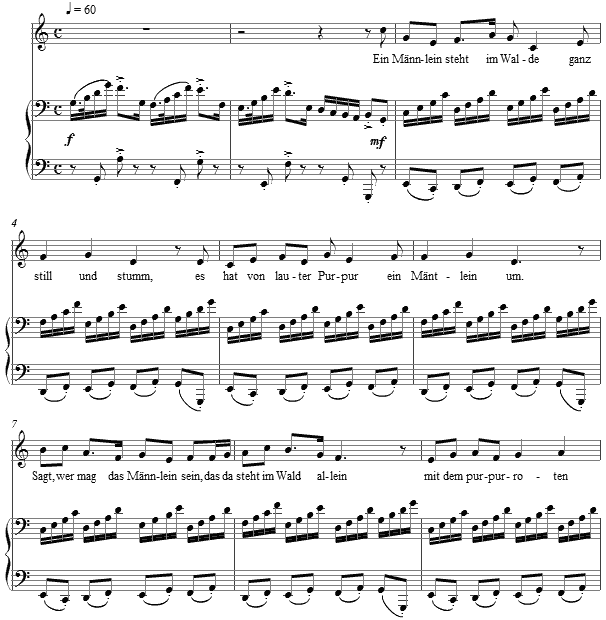Music and Texts of GARY BACHLUND
Vocal Music | Piano | Organ | Chamber Music | Orchestral | Articles and Commentary | Poems and Stories | Miscellany | FAQs
Rätsel - (2008)
August Heinrich Hoffmann von Fallersleben
for medium voice and piano
Ein Männlein steht im Walde
ganz still und stumm,
es hat von lauter Purpurein Mäntlein um.
Sagt, wer mag das Männlein sein,
das da steht im Wald allein
mit dem purpurroten Mäntelein?
Das Männlein steht im Waldeauf einem Bein
und hat auf seinem Haupteschwarz Käpplein klein.
Sagt, wer mag das Männlein sein,
das da steht im Wald allein
mit dem kleinen schwarzen Käppelein?[ 2 pages, circa 1' 35" ]
A little fellow stands in the woods
completely still and silent,
and has garish purple
coat on.
Say, who might this little fellow be,
that stands alone in the woods
with the reddish purple coat?
The little fellow stands in the woods
on one leg
and has on his head
a little black hat.
Say, who might that little fellow be,
that stands alone in the woods
with the little black cap?
The text is sometimes titled Rätsel, as in my text, and sometimes as Das Männlein im Walde. It is noted as written in December of 1843, and collected as Kinderlieder, though some sources suggest the text was written a year earlier. Puzzles such as these were quite popular, and other forms of puzzles entertain today. Hoffmann von Fallersleben used the form of the puzzle sometimes to state quite large themes as well, including issues of national sentiment and the economy of the day, these offered as puzzles for which he had no answer. The answer to these small riddles is below. [ 1 ]
The score for Rätsel is available as a free PDF download, though any major commercial performance or recording of the work is prohibited without prior arrangement with the composer. Click on the graphic below for this piano-vocal score.
NOTES
[ 1 ] Also known by a folk song melody, other variants on the words suggest other colors, but the general effect is the same.
Sometimes called the dog rose, Hagebutte is a hardy plant which has in winter a rose hip that stands erect, unlike most of the various wild berries whose fruit hangs; therefore some solve the puzzle by referring to this plant. For this, there is a third sometimes spoken verse known in variant folk versions, which as the solution reads:
Das Männlein dort auf einem Bein
mit seinem roten Mäntelein
und seinem schwarzen Käppelein
kann nur die Hagebutte sein!Some others propose that the answer to the puzzle is the mushroom known fly agaric, its genus and species being Amanita muscaria and having a supposed ability to attract and kill flies. The hallucinogenic chemicals this mushroom contain are muscimol and ibotenic acid.
The fly agaric is related to some deadly mushrooms: the Amanita virosa (the "Destroying Angel"); Amanita verna and Amanita phalloides (the "Death Cap"). Symptoms include blurred vision, loss of motor skills, moderate to extreme nausea or cramps, physical relaxation or a sedative like effect, euphoria and a “dream like” state of being. The experience is said to be very different from that of psilocybin and many do not enjoy it.
People who eat these mushrooms sometimes fall into a deep sleep, and others as similar to being intoxicated by alcohol. Some report visionary effects, which are often characterized by synaesthesia, begin after they awaken and can last for several hours. Reports of visions of giants in the world of dwarfs are remarkably common, which might offer some additional explanation for these various characters in folk tales.
Given that the poem refers to a possibly poisonous mushroom, this reflects the adage, "there are bold mushroom hunters and old mushrooms hunters, but there are no bold, old mushroom hunters."

